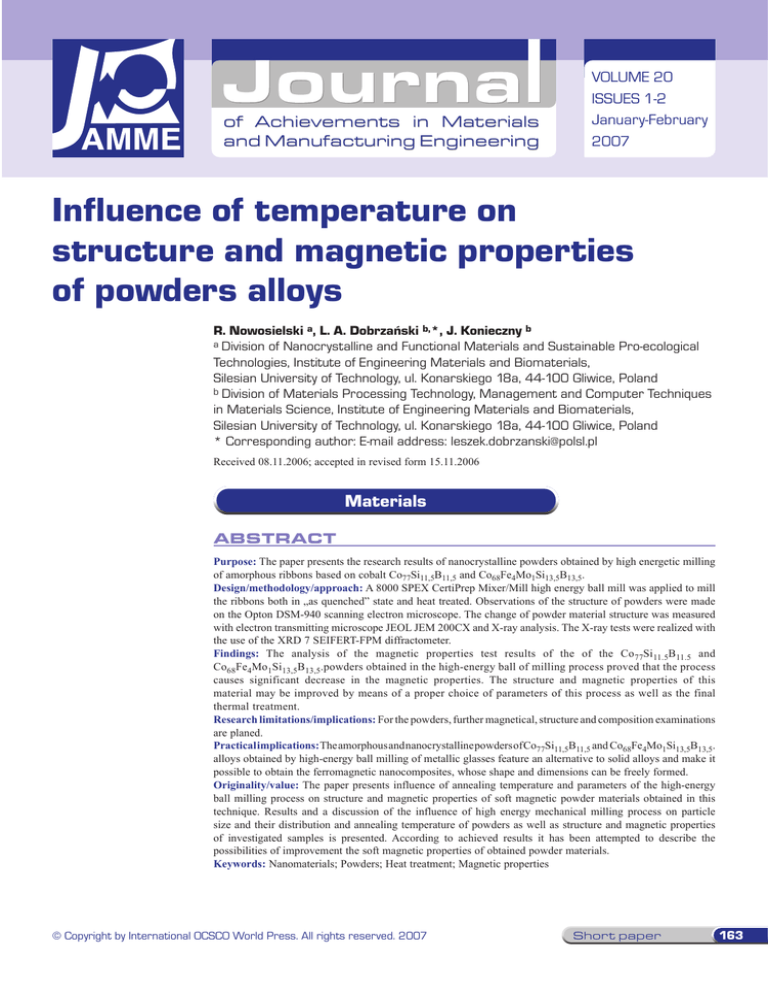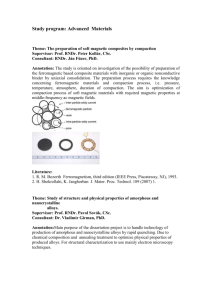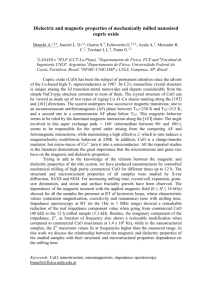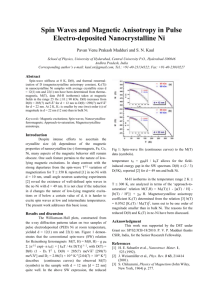
of Achievements in Materials
and Manufacturing Engineering
VOLUME 20
ISSUES 1-2
January-February
2007
Influence of temperature on
structure and magnetic properties
of powders alloys
R. Nowosielski a, L. A. Dobrzański b,*, J. Konieczny b
a Division of Nanocrystalline and Functional Materials and Sustainable Pro-ecological
Technologies, Institute of Engineering Materials and Biomaterials,
Silesian University of Technology, ul. Konarskiego 18a, 44-100 Gliwice, Poland
b Division of Materials Processing Technology, Management and Computer Techniques
in Materials Science, Institute of Engineering Materials and Biomaterials,
Silesian University of Technology, ul. Konarskiego 18a, 44-100 Gliwice, Poland
* Corresponding author: E-mail address: leszek.dobrzanski@polsl.pl
Received 08.11.2006; accepted in revised form 15.11.2006
Materials
Abstract
Purpose: The paper presents the research results of nanocrystalline powders obtained by high energetic milling
of amorphous ribbons based on cobalt Co77Si11,5B11,5 and Co68Fe4Mo1Si13,5B13,5.
Design/methodology/approach: A 8000 SPEX CertiPrep Mixer/Mill high energy ball mill was applied to mill
the ribbons both in „as quenched” state and heat treated. Observations of the structure of powders were made
on the Opton DSM-940 scanning electron microscope. The change of powder material structure was measured
with electron transmitting microscope JEOL JEM 200CX and X-ray analysis. The X-ray tests were realized with
the use of the XRD 7 SEIFERT-FPM diffractometer.
Findings: The analysis of the magnetic properties test results of the of the Co 77Si11.5B11.5 and
Co68Fe4Mo1Si13,5B13,5.powders obtained in the high-energy ball of milling process proved that the process
causes significant decrease in the magnetic properties. The structure and magnetic properties of this
material may be improved by means of a proper choice of parameters of this process as well as the final
thermal treatment.
Research limitations/implications: For the powders, further magnetical, structure and composition examinations
are planed.
Practical implications: The amorphous and nanocrystalline powders of Co77Si11,5B11,5 and Co68Fe4Mo1Si13,5B13,5.
alloys obtained by high-energy ball milling of metallic glasses feature an alternative to solid alloys and make it
possible to obtain the ferromagnetic nanocomposites, whose shape and dimensions can be freely formed.
Originality/value: The paper presents influence of annealing temperature and parameters of the high-energy
ball milling process on structure and magnetic properties of soft magnetic powder materials obtained in this
technique. Results and a discussion of the influence of high energy mechanical milling process on particle
size and their distribution and annealing temperature of powders as well as structure and magnetic properties
of investigated samples is presented. According to achieved results it has been attempted to describe the
possibilities of improvement the soft magnetic properties of obtained powder materials.
Keywords: Nanomaterials; Powders; Heat treatment; Magnetic properties
© Copyright by International OCSCO World Press. All rights reserved. 2007
Short paper
163
Journal of Achievements in Materials and Manufacturing Engineering
Volume 20 Issues 1-2 January-February 2007
1.
Introduction
1. Introduction
The amorphous and nanocrystalline materials arouse interest
of scientists in research centres all over the world in the last tree
decades. This is connected with the soft magnetic properties
characteristic for these materials and with the possibility of using
them in the electronic and electrical industry [1-9].
The metallic amorphous and nanocrystalline materials obtained
by crystallization of the metallic glasses are available in the form of
thin ribbons only, and their magnetic properties can be controlled
by heat- or thermo-magnetic treatment. These limitations are
complicated in addition by the feasibility of manufacturing only
toroidal cores from the ribbons.
Obtaining the nanocrystalline metal powders by milling of metallic
glasses features an alternative to solid materials like amorphous and
nanocrystalline ribbons and makes it possible to obtain the
ferromagnetic nanocomposites, whose shape and dimensions can be
freely formed using various consolidation methods [10-15].
2.
Material
methods
2.
Material
andand
methods
The investigations were carried out on a Co77Si11,5B11,5 and
Co68Fe4Mo1Si13,5B13,5.metallic glass in form of 0.036 mm thick
and 10.2 mm wide ribbons. A 8000 SPEX CertiPrep Mixer/Mill
high energy ball mill was applied to mill the ribbons both in „as
quenched” state and heat treated. The vibration times were 5, 10,
15, 20 and 25 hours. A THERMOLYNE F6020C resistance
furnace was used for isothermal soaking of the amorphous
ribbons and the powder. Soaking was carried out at temperature
range 300÷600oC with 100oC step in the argon atmosphere.
The X-ray tests were realized with the use of the XRD 7
SEIFERT-FPM diffractometer equipped with the lamp of the cobalt
anode of 35 kV voltage and 30 mA filament current was used.
Diffraction tests were carried out in the 2T angle range from 40 to
120° (measurement step 0,1o). Pulse counting time was 5 s.
Microscope examinations were made under the OPTON DSM
940 electron scanning microscope and the JEOL JEM 200CX
electron transmision one. Tests of magnetic properties were
carried out by the use of Lake Shore’s Vibrating Sample
Magnetometer VSM model 7307.
A MICROCAL ORIGIN 6.0 programme was used for the
graphical analysis of the obtained X-ray photographs and
Hc=f(TA) relation.
3.Results
discussion
3. Results andand
discussion
The observation of materials in the scanning microscope
proved that the high energy ball milling of the amorphous
Co77Si11,5B11,5 ribbon lasting 5 hours, results in the production of
flakes of ribbons (“scales”). The shape of powder grains changes
together with the time of milling. After 5-hour milling the shape
of grains resembles flakes and after 15-hour milling the grains are
smaller and more spherical (Fig. 1).
It was revealed, basing on magnetic examinations of powder
material, that the coercion field value increases throughout the entire
high energy milling time span and reaches its max. of HC= 2610
A/m for the powder obtained after 25 hours of milling (Fig. 2).
164
Short paper
Fig. 1. Powder Co77Si11,5B11,5 grains image after a) 5 h, b) 15 h,
c) 30 h of the high energy miilling, scanning microscope
The saturation induction BS value grows also along with the
milling time. The BS value for the powder obtained after 5 hours
of milling is 0.63 T.
The powder obtained after 20 hours of the high energy milling
characterized by the saturation induction of BS=0.74 T. The BS
value increases as the milling process continues - like the coercion
field value, reaching 0.77 T after 25 hours of milling. Increase of
the coercion field HC and of the saturation induction BS takes place
at the further stage of the process, as the milling time gets longer.
Fig. 2. Coercion field and saturation induction versus milling time of
powders obtained from the Co68Fe4Mo1Si13,5B13,5 amorphous ribbons
The magnetic research of the Co77Si11,5B11,5 powders obtained
in the process of milling of the ribbons in the “as quenched” state
proved that the process of the high energy ball milling causes
significant increase in the coercive force. The powder obtained
after 5-hour milling of the amorphous ribbon is characterised by
the highest value of the coercive force field (HC=517,1). The
longer the time of milling is, the higher the value of the parameter
after 10-hour milling HC=549,1A/m. Further increase in the
milling time causes only slight changes of the HC with slight
increasing tendency (Fig. 3).
The longer the milling process, the smaller the value of the
saturation of magnetization, which for the powder obtained after
5-hour milling of the amorphous Co77Si11,5B11,5 ribbon amounts to
BS=0,85 T. For the powder obtained in 10-hour milling, the value
BS equals 0,858 T. The value of the saturation of induction
maintains at the same level for all samples after 15, 20 and 25
hours of milling (BS=0,86÷0,88 T).
R. Nowosielski, L. A. Dobrzański, J. Konieczny
Materials
Co 3B
(023)
(004)
(122)
(202)
(121)
(100)
Co- E
(002)
(112)
(020)
Intensity
(002)
Magnetic properties of powder materials may be improved by
heat treatment. The research revealed that the isothermal
annealing causes lowering the coercion field value of the powder
material with the saturation induction unchanged. However, the
excessively high isothermal annealing temperature causes the
significant growth of the coercion field value (Fig. 4A.).
(101)
Fig. 3. Coercion field and saturation induction versus milling time of
powders obtained from the Co77Si11,5B11,5 amorphous ribbons
The optimum isothermal annealing temperature for the
powder material obtained by the high energy milling of the
Co68Fe4Mo1Si13,5B13,5 amorphous ribbon for 5 hours, after which
it demonstrates its best soft magnetic properties, is 300°C K for 1
hour (HC=111.7 A/m). After holding the powder at a temperature
of 400°C for 1 hour, its coercion field value increases reaching
HC=152.2 A/m, and the saturation induction reaches BS=0.67 T.
Further powder annealing temperature rise to 500°C causes
further growth of the coercion field and saturation induction,
which reach values of HC=279.7 A/m and BS=0.69 T respectively.
However, the coercion field is HC=16624 A/m and the saturation
induction decreases and is BS=0.65 T after annealing the powder
at 600°C K for 1 hour (Fig. 4B).
For powders obtained after 5 hours of milling and at the
following stage – heated, similar effects as in the case of
amorphous ribbons heating were achieved. Similar results were
obtained in the research [14] where the Co-based amorphous alloy
ribbons were needed. In this case, the relation of the coercive field
to the temperature of heating was similar to the one presented in
Fig. 4. It is probable that the isothermal heating of powders
provoked the relaxation of stress appeared in the process of high
energetic milling. All this is responsible for the change of the
magnetic properties of powders.
On the basis of the analysis of the electron diffraction pattern
(fig. 5) it may be supposed that apart from the stress relaxation,
the process of heating results in the structural changes which
consists in new phase nucleation in higher temperatures.
b)
a)
40
50
60
70
80
90
2 T [°]
Fig. 4. A) Coercive force HC, B) Magnetic flux density BS values
versus annealing temperature Ta of the powder obtained from the
Co68Fe4Mo1Si13,5B13,5 and Co77Si11,5B11,5 ribbons after 5 hours of
high-energy ball milling
Fig. 5. X-ray phase diagram of the powder A) Co77Si11,5B11,5, and
B) Co68Fe4Mo1Si13,5B13,5 obtained after milling for 5 hours and
subsequently heated in the temperatures of a) 300 and b) 600°C
Influence of temperature on structure and magnetic properties of powders alloys
165
Journal of Achievements in Materials and Manufacturing Engineering
It was found out, basing on examinations of thin foils under
the transmission electron microscope that the powder obtained
after 5 hours of the high energy ball milling and subsequently heated
in termal in temperature 600°C/1h in argon has a nanocrystalline
structure (Fig. 6). In addition, spectral line from the (111), (002),
(113) and Co-D, (011), (022), (023), (121), (024) and Co-E, as well as
spectral line from the (021), (103), (222) and Co3B cobalt boron, were
identified in the amorphous structure of the powder.
Volume 20 Issues 1-2 January-February 2007
[2]
[3]
[4]
[5]
[6]
[7]
Fig. 6. Structure of the powder grain obtained after 5 hours high
energy ball milling amorphous ribbon Co68Fe4Mo1Si13,5B13,5 and
subsequently heated in thermal in temperature 600°C/1h in argon;
transmission electron microscope,180000×
[8]
4. Conclusion
4.Conclusions
[9]
It was found out in observations on the scanning electron
microscope that along with the milling time increase the powder
particles size decreases, and that their shape changes also during
the process. The powder grains were flake-sized at the first stage
of the process, and actually they were parts of the ribbons.
However, as the milling time grows the grains become spherical
with a clear tendency to get smaller.
The magnetic tests of the Co68Fe4Mo1Si13,5B13,5 and
Co77Si11,5B11,5 powders obtained in the high-energy ball of milling
process proved that the process causes significant decrease in the
magnetic properties. A specially significant is the growing value
of coercion field with milling time. The saturation magnetization
does not change, or its changes do not have a clear effect on the
magnetic properties. As the milling time passes the coercion field
decreases; anyway, it grows again with the extended milling time.
On the basis of the research done, it was stated that the
process of the high-energy ball milling combined with thermal
crystallisation of the Co77Si11,5B11,5 and Co68Fe4Mo1Si13,5B13,5
alloy, results in the production of the nanocrystalline powder
material. The structure and magnetic properties of this material
may be improved by means of a proper choice of parameters of
this process as well as the final thermal treatment.
References
References
[1]
166
T. Bitoh, A. Makino, A. Inoue, The effect of grain-size
distribution on coercivity in nanocrystalline soft magnetic
Short paper
[10]
[11]
[12]
[13]
[14]
[15]
alloys, Journal of Magnetism and Magnetic Materials 272–
276 (2004) 1445–1446.
A. Makino, A. Inoue, T. Masumoto, Soft magnetic
properties of nanocrystalline Fe-M-B (M=Zr, Hf, Nb) alloys
with high magnetization, Nanostructured Materials, Vol.: 6,
5-8 (1995) 985-988.
S. Lesz, R. Nowosielski, B. Kostrubiec, Z. Stokáosa,
Crystallization kinetics and magnetic properties of Co-based
amorphous alloys, Journal of Achievements in Materials
and Manufacturing Engineering, 16, 1-2 (2006) 35–39.
Y. Naitoh, T. Bitoh, T. Hatanai, A. Makino, A. Inoue, T.
Masumoto, Applications of nanocrystalline soft magnetic
Fe-M-B (M = Zr, Nb) alloys, Nanostructured Materials,
Vol.: 8, Issue: 8, (1997) 987-995.
A. Inoue, A. Makino, Improvement of soft magnetic properties
of nanocrystalline Fe-M-B (M-Zr and Nb) alloys and their
applications, Nanostructured Materials, Vol.: 9, 1-8, (1997)
403-412.
A. Makino, T. Hatanai, A. Inoue, T. Masumoto, Nanocrystalline
soft magnetic Fe-M-B (M=Zr, Hf, Nb) alloys and their
applications, Materials Science and Engineering, Vol.: 226228, (1997) 594-602.
A. Makino, A. Inoue, T. Masumoto, Nanocrystalline soft
magnetic Fe-M-B (M = Zr, Hf, Nb), Fe-M-O (M = Zr, Hf,
rare earth) alloys and their applications, Nanostructured
Materials, Vol.: 12, 5-8 (1999) 825-828.
G. Bordin, G. Buttino, A. Cecchetti, M. Poppi, Temperature
dependence of magnetic properties of a Co-based alloy in
amorphous and nanostructured phase, Journal of Magnetism
and Magnetic Materials, 195 (1999) s. 583.
M. Vazquez, M. Knobel, M. L. Sanchez, R. Valenzuela, A.
P. Zhukov, Giant magnetoimpedance effect in soft magnetic
wires for sensor applications, Sensors and actuators A:
Physical, Vol.: 59, Issue: 1-3 (1997) 20-29.
R. Nowosielski, L.A. DobrzaĔski, J. Konieczny, Structure and
magnetic properties of powders soft magnetic nanocrystalline
materials based cobalt, Proc. 11th Intern. Scientific Conf.
AMME’2002, Gliwice- Zakopane, (2002) 363-368.
R. Nowosielski, L. A. DobrzaĔski, S. Griner, J. Konieczny,
Structure and magnetic properties of powders soft magnetic
nanocrystalline materials obtained on combine thermal
nanocrystallization and high-energy ball milling, process
Proc. 11th Intern. Scientific Conf. AMME’2002, GliwiceZakopane, 2002, pp. 369-372.
P.G. Bercoff, H.R. Bertorello, High-energy ball milling of
Ba-hexaferrite/Fe magnetic composite, Journal of
Magnetism and Magnetic Materials, 187 (1998), 169-172.
L.A. DobrzaĔski, R. Nowosielski, J. Konieczny, The structure
and magnetic properties of magnetically soft cobalt base,
nanocrystalline powders and nanocomposites with silicon
binding, Journal of Materials Processing Technology 155–
156 (2004) 1943–1949.
R. Kolano, A. Kolano-Burian, Amorphous and nanocrystalline
soft magnetic materials – New generation materiales for
electronics, Electrotechnical Review, 11 (2002) 241-248.
R. Nowosielski, L.A. DobrzaĔski, P. Gramatyka, S. Griner,
J. Konieczny, Magnetic properties of high-energy milled
Fe78Si13B9 nanocrystalline, powders and powder-based
nanocomposites, Journal of Materials Processing
Technology 157–158 (2004) 755–760.
READING DIRECT: www.journalamme.org







